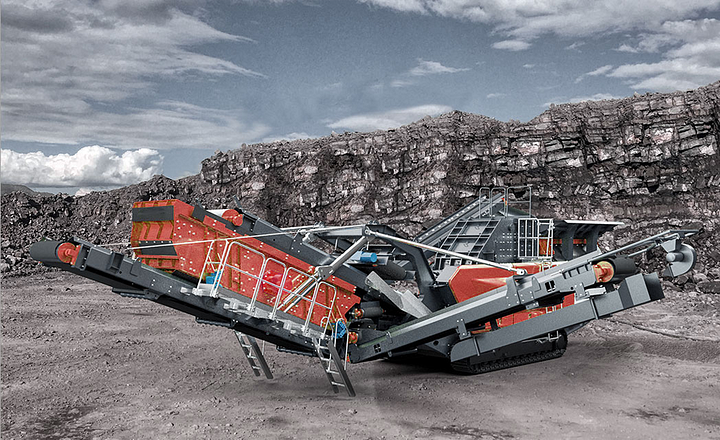SUPPORT
© 2023 Dingbo All rights reserved
The development of mobile station is the embodiment of the continuous progress of society and the continuous improvement of crusher technology, there are two kinds of equipment to choose from in terms of mobile station, one is the tire type mobile crushing plant and the crawler type mobile crushing plant, its design concept eliminates the obstacles to the crushing operation brought by the crushing site, environment, complicated basic configuration and complicated logistics, so it is welcomed by more and more users. This article starts from the similarities and differences between the two types of mobile crushing plants, and analyzes their characteristics and respective advantages for you. Tire type and track type have common features
1. Flexible and time-saving
The mobile crusher can directly reach the mining site, not affected by the change of the site, and can start the operation after completing the station adjustment in a short time, due to the small size of the equipment, it is especially suitable for the narrow place of the crushing site. At the same time, it eliminates the cumbersome steel frame structure and foundation construction when crushing, saving a lot of time.
2. Integrated complete set of units
The installation form of integrated unit equipment eliminates the complicated site infrastructure installation of split components, reduces the consumption of materials and man-hours, and is a production line integrating process equipment such as material receiving, crushing, and transmission. The reasonable and compact space layout of the unit improves the flexibility of the site.
3. Reduce the cost of material transportation
The mobile crushing plant can process materials on site without having to move materials away from the site for reprocessing, which greatly reduces the transportation cost of materials.
4. The combination is flexible and the functions are complete
According to the actual production requirements of the user, it is equipped with corresponding equipment, and a variety of combinations can be composed, which can be composed of “first crushing and then sifting”, and can also be composed of “first sieving and crushing” process, which can be combined into a two-stage crushing and screening system of coarse crushing and fine crushing, and can also be combined into a three-stage crushing and screening system of coarse crushing, medium crushing and fine crushing, and can also operate independently, which has great flexibility.

Comparison of the differences between tire type and track type
In addition to the above common characteristics, the two also have their own unique advantages, and we compare them from the following aspects:
1. Easy to move
In fact, the tire type mobile crusher plant cannot be completely called a mobile crusher, because its transition movement depends on the semi-trailer head for traction, so it is not as good as the self-propelled hydraulic driven crawler type mobile crusher plant in terms of action.
2. The site is flexible
Because the tire-tired mobile crushing plant adopts vehicle-mounted traction, it is more suitable for crushing various sand and gravel materials in some construction waste treatment, earthwork engineering, urban infrastructure and road construction, construction and other industries.
The chassis of the crawler mobile crusher adopts a crawler fully rigid ship-type structure, with high strength, low grounding specific pressure, good passability, good adaptability to mountains and wetlands, and even can realize climbing operations, so it is mostly used in some harsh operating environments such as mining and open-pit coal mining. However, because it is convenient and fast to move, it is now more used for the crushing and processing of urban construction waste, and the production of many mining machine manufacturers is also mainly crawler.
3. High work efficiency
When the tire-tired mobile crushing plant works, because the hydraulic outriggers under the frame are fixed, the stability of the whole station is increased, and the stability is the basis of the operation of the mobile crushing plant, and the good stability makes the whole station can be equipped with large-scale crusher equipment, which means that the tire-tired mobile crushing plant can carry out the crushing operation of large-scale materials, and the work efficiency is extremely high.
The stability of the crawler mobile crusher is weak, which leads to its crushing capacity not being as efficient as that of the tire mobile crusher.
4. Equipment performance
The wheelbase of the tire mobile crusher plant is short, the turning radius is small, and the road surface is not damaged, and it can be driven flexibly on ordinary highways and in the operation area.
The crawler mobile crushing plant uses crawler walking, which can realize in-situ steering, and the standard configuration, through wireless remote control, is very easy to drive the crusher to the trailer and transport it to the operation site.
5. Good grain shape
At present, the mobile crushing plant is used in the crushing treatment of construction waste, and the recycled aggregate produced by the mobile has good particle shape, which is conducive to recycling. The semi-open discharge system is suitable for crushing construction waste containing a small amount of steel bars, with fine discharge, less over-crushing, and good particle forming, especially suitable for the production of environmentally friendly bricks.
6. The price is reasonable
Generally speaking, the price of crawler mobile crushing plant is more expensive than that of rubber tyred mobile crushing plant of the same series.
To sum up, the tire type and the crawler type mobile crushing plant have their own characteristics, which should be selected according to the production requirements of the user. With people’s pursuit of efficiency and convenience, mobile crushing plants will be more used in all walks of life, understand the characteristics of these two types of mobile crushing plants, and lay the foundation for the selection of current or future equipment.